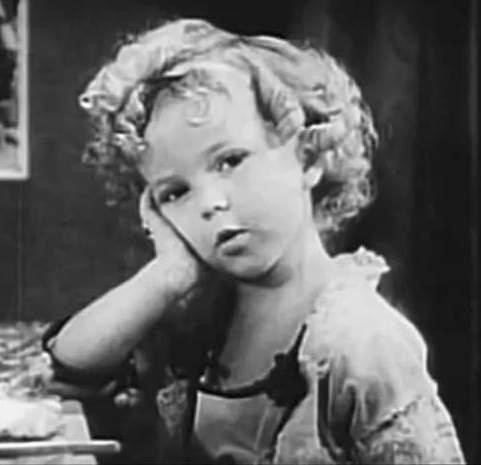
Shirley Temple in a still from the 1933 film Glad Rags to Riches.
April 23 will mark the birthday of Shirley Temple (1928-2014). Anniversaries of the birth or death of stars are frequently relegated to the category of minutiae—internet trivia quizzes, daily calendar notations, the online “on this day in history” reminder. We may find a few seconds or even minutes for this reminder, but how often does it spark reflection on how our lives are intertwined with popular culture history? On how our anxieties and joys are impacted by visual and sonic forms, personalities, and performers? Reflecting on Shirley Temple’s career as a child actor is not meant to be a nostalgic gesture towards a star whose peak was in the 1930s and who retired from the screen in 1950, but a reminder of the power of movies and the need to contextualize stardom as an experience, a potential source of meaning, and an investment of feeling.
Shirley Temple was a star among stars. She became one of the most famous and successful movie stars of the 1930s, an era marked by economic suffering and environmental disaster in the United States, the rise of fascism, and political upheaval internationally. Her breakthrough feature film, Stand Up and Cheer (1934) revolved around the fanciful idea of a government-organized entertainment department employing out-of-work entertainers. Twenty-two money-making films followed as she appealed to adults and children until her profit-making run ended in 1939. Not only was she the first child actor to rank among Hollywood’s yearly top-ten studio money earners for a record six years, but she achieved the pinnacle as the number-one-ranked U.S. box-office attraction for four years running (1934-1937). The enormous success of her films, year after year, saved a newly reorganized Fox Film Corporation (20th Century Fox). Temple also was successfully commodified off-screen through “tie-ups.” By 1940 five million Shirley Temple dolls were in the hands of little girls as well as Temple-branded or endorsed glassware, books, clothing, school supplies, food products, and sheet music. She became the most photographed person in the world and the youngest individual ever listed in Who’s Who.
Bill “Bojangles” Robinson, partner to Temple in what was U.S. film’s first interracial dance teaming, said of her: “God made her just all by herself—no series, just one.” In spite of this assertion of her uniqueness, numerous Shirley Temple look-like, dance-alike, sound-alike contests were held in the United States and other White-dominated countries. The Saturday Evening Post suggested that mothers were not wrong to see their own little girls as potential Shirleys who might be desired by Hollywood studios who were eagerly screen testing girls: “No fields are trilled for oil, no hills are mined for gold with more desperation … more persistence … more prayers … somewhere there must be another Shirley Temple.”
Like all movie stars, Temple was an economic commodity Hollywood wanted to reproduce, but her star persona resonated in ways unprecedented for a child actor. President Franklin Delano Roosevelt praised Temple for what she did in uplifting the nation’s morale during the depths of the Great Depression: “When the spirit of the people is lower than at any time during this Depression, it is a splendid thing that for just 15 cents, an American can go to a movie and look at the smiling face of a baby and forget his troubles.” Congress declared Temple to be “the most beloved individual in the world.” In the 1970s, scholar Charles Eckert argued that Temple’s screen power was rooted in her films’ emphasis on her “capacity for love” that she gave it to all who needed it, thus making love into a social and even “political force on a par with the idea of democracy or the Constitution.”
With stories often displaced to other historical moments but resonating with contemporary concerns, Temple’s films were utopian: her characters inevitably overcame adversity through her charisma. The key goal was to achieve the domestication of a man who would find his own happiness in setting right the child’s state of being abandoned or orphaned. This was by no means a new literary or theatrical trope, but Temple’s films updated its girl heroine who emotionally rescues a man who—often reluctantly—rescues her. Temple was not a girly-girl, all dimples and curls, smiles, and tears. Nicknamed “Butch” by film crews and a self-declared “tomboy,” Temple played determined little girls who enjoyed playing at being a soldier or sailor, who were not beyond spitting, throwing mud, or other mischiefs. Her physical vitality seemed to embody hope for the future while her cheerful sweetness salved fears associated with children and families in a decade when 25 percent of American men were out of work, and husbands and fathers who could not cope with the strain of unemployment and failure sometimes just walked away.
Can we, in our twenty-first-century world, imagine a movie star or any other celebrity performer now assuming such an outsized role in our cultural imaginary as Shirley Temple appears to have played in the 1930s? In remembering her, our curiosity might best be aimed at seeing and appreciating her films for what they are, texts that demand to be historically contextualized, even as we reflect on the ways current popular culture seeks to soothe (or sometimes stoke?) anxieties that characterize the present day. Temple’s remarks to an interviewer in 1977, are instructive: “We all learn a lot from the past—it’s just that we shouldn’t live there.”
